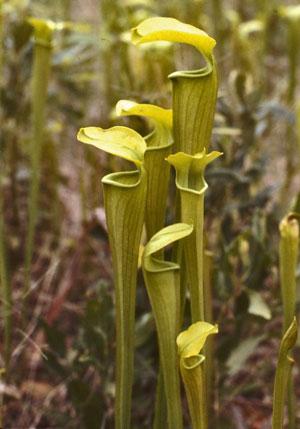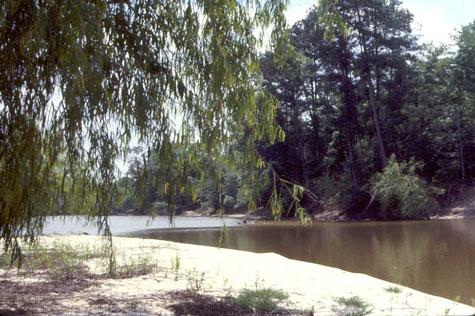Any park in the country has certain times of the year when a visit is especially enjoyable, and for Big Thicket National Preserve, a prime season for outdoor activities is upon us. Compared to more northerly climes, spring comes early to southeast Texas, and March and early April can offer a fine time hiking and boating in an area that's not your typical national park.
Big Thicket is a relatively new, and still largely undiscovered, unit of the National Park System, even though parts of this area are within a two-hour drive of Houston. The area has no developed campgrounds and no entrance stations; only a few short roads'most of them unpaved'even extend into the park. As a result the best way to enjoy the Big Thicket is on foot or via the water, but it's easy to explore via short walks or float trips.
The Preserve now contains over 112,000 acres of land and water, but it's unusual in one other regard. This park isn't found in just one location, because all that acreage is divided into 15 units, spread over 7 counties in southeast Texas. Some of those units are contiguous, strung together along several waterways, while others are stand-alone locations. The largest unit covers 14,300 acres, the smallest 550 acres.
So, what's special about this place?
One distinction is the park is home to thousands of carnivores...but none of them bite, unless you're a bug. Included among the area's 1,300 species of trees, shrubs, vine and grasses are four types of carnivorous plants: pitcher plants, sundews, butterworts, and bladderworts. Also at home here are 20 species of wild orchids, some 60 species of mammals and 175 species of birds.
The Big Thicket has sometimes been described as "the biological crossroads of North America," a term that stems from the area's rich biological diversity. The park website explains that "a convergence of ecosystems occurred here during the last Ice Age, bringing species from very different habitats together in one relatively small area. Cacti and yucca grow near longleaf pines, while southern magnolias grow near beech and bald cypress trees."
Those intriguing carnivorous plants are among the best reasons to visit this area in the spring; their blooms are attractive and unusual, and the insects which provide part of their diet are a lot less active in early spring than they will be during the very warm and humid summer season!

Pitcher plants. Jim Burnett photo.
Top spots for these unusual plants are along two short trails: the Pitcher Plant Trail in the park's Turkey Creek Unit or the Sundew Trail in the Hickory Creek Savannah Unit. Both offer easy walks, suitable for visitors of all ages and fitness levels.
For the larger concentration of carnivorous plants, check out the aptly-named Pitcher Plant Trail, located on the northeast side of the park's Turkey Creek Unit. This short trail leads through a mixed pine forest to the edge of a wetland savannah, and a boardwalk provides excellent views of pitcher plants and sundews. Past the savannah, the trail loops through a mixed hardwood-pine forest. The total round-trip trail distance is approximately one mile.
In addition to the bug-catching plants, the Sundew Trail is also one of the best places in the preserve to see birds and other varieties of wildflowers. Both the inner 0.25-mile loop and outer 1-mile loop of the trail pass through a small bog that supports pitcher plants and sundews.
The inner loop continues through a savannah that has abundant summer wildflowers, while the outer loop winds through a woodland composed primarily of longleaf pines. The trailhead is located on CR 1910, 0.5 mile south of FM 2827 and approximately 7 miles north of the Big Thicket National Preserve Visitor Center.
You'll find more information about these and other trails in the park at this link.

A canoe or kayak is a great way to explore magnificent bottomland hardwood stands. USDA photo.
Another great way to explore this area is by canoe or kayak, and the 21-mile Village Creek Paddling Trail is a favorite route; it winds past beautiful white-sand beaches and beneath impressive tall trees, including bald cypress, tupelo, and other hardwoods. Four separate access points allow you to break this float into trips as short as 2.1 miles.
Looking for even longer trips by water? The park includes 80 miles of the Neches River, with distances between boat ramps varying from 10 to 40 miles. There are plentiful opportunities for side trips off the river into bayous and sloughs through bottomland hardwood forests, but pay attention to your navigation if you leave the main river or creek'it's very easy to get turned around in those areas. You'll find more information about canoeing, kayaking, and primitive camping along the Neches River at this webpage.
Unless you're well acquainted with the area, you'll benefit from a good map and some local advice before starting your visit, and you'll find both at the park Visitor Center, which is found at 6102 FM 420, Kountze, Texas. That location is eight miles north of the small town of Kountze, and approximately 30 miles north of Beaumont via US 69/287. The center is open daily from 9 a.m. to 5 p.m. except for Thanksgiving, Christmas and New Years Day.
The park cautions that some GPS systems will lead you astray about the Visitor Center's location, so you can find your route to the Visitor Center, or get an overview of the park, by using the map available on the park website: click on the "View park map" link on the lower left side of the park website's homepage. You can zoom in and out with this map for the big picture or details on specific locations. If you need help with directions, you can phone the Visitor Center at (409) 951-6700
If you're interested in developed campgrounds in the vicinity of the park, two good options are Village Creek State Park, right in the heart of the "Thicket," and Martin Dies, Jr. State Park, about 45 minutes northeast of the NPS Visitor Center. A Google search easily will turn up several private campgrounds in the area, along with several B&B's, cabins and motels. A wider selection of hotels and restaurants is available in Beaumont, a 45-minute drive south of the park Visitor Center.
Looking for a different kind of park visit? There's probably not another national park in the county where you can stroll unconcerned among so many hungry carnivores, and never have to look over your shoulder! Additional information to help plan a visit is available on the park website.


 Support Essential Coverage of Essential Places
Support Essential Coverage of Essential Places






